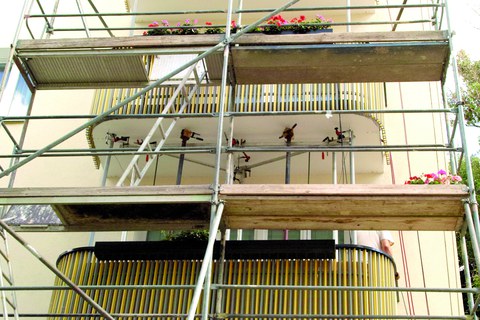Stress tests on balconies
Table of contents
Project data
| Titel | Title Belastungstests an Balkonen der Wohnungsgenossenschaft Post Dresden eG | Stress tests on balconies of the Wohnungsgenossenschaft Post Dresden eG Prüfingenieur | Test engineer Dipl.-Ing. Jochen Simon (VPI) Beauftragter Koordinationsingenieur | Engineer responsible for coordination Dipl.-Ing. Christian Wuttke Gutachter | Assessor Univ.-Prof. i.R. Dr.-Ing. habil. Heinz Opitz Zeitraum | Period 06.2012 – 07.2012 Leiter | Project Manager Dipl.-Ing. Thomas Popp |
Report in the yearbook 2012
Load tests on balconies

stress tests on balconies
On Dresden apartment blocks (built in 1956), some balconies showed cracks in the sealing layer. As part of an investigation to find the causes of these cracks, a reinforcement depth test was also carried out. This revealed considerable deviations between the planned position of the reinforcement and the actual position and in the amount of reinforcement. If this is taken into account in the structural analysis for current standard loads, it is not possible to demonstrate adequate stability. However, a complete renovation of the more than 100 balconies would represent a considerable financial expense. Therefore, the structural safety was to be verified by an on-site load test. The tests had a chance of success, as the balconies showed no damage in terms of load-bearing capacity after more than 50 years of use.
In order to be able to represent all balconies, four 3.80 m wide balconies, one above the other, with a cantilever of 1.50 m were selected for the test. The area load to be verified according to DIN 1055 was realized by an equivalent line load, which was entered in the center of the balcony via 30 × 60 cm wooden plates. The load was applied via tie rods, each of which was attached to two U-beams. Two concrete slabs served as supports. The tensile forces were generated by hydraulic presses. Although the increase in deflection observed online during loading allows failure to be detected in good time and immediate unloading to take place, a fall arrest system was provided for the balcony slabs as a precaution.
The test limit load of 6.0 kN/m² was determined from the characteristic values of the action. The load was applied in stages with intermediate unloading. The load steps were chosen to be relatively small in order to be able to detect any failure in good time. Subsequently, a permanent load of 4.0 kN/m² was applied for 20 min. The deflections of all four balconies remained constant.
The in-situ tests showed, among other things, that the characteristic live load of 4.0 kN/m² prescribed by DIN for balconies can be borne by the investigated components without damage. The deflections at the cantilever end remained so low even when the test target load was applied that the tensile strength of the concrete at the top was not exceeded. As a result of the load tests, it is now possible to continue using the balconies in their current form without expensive refurbishment measures.
